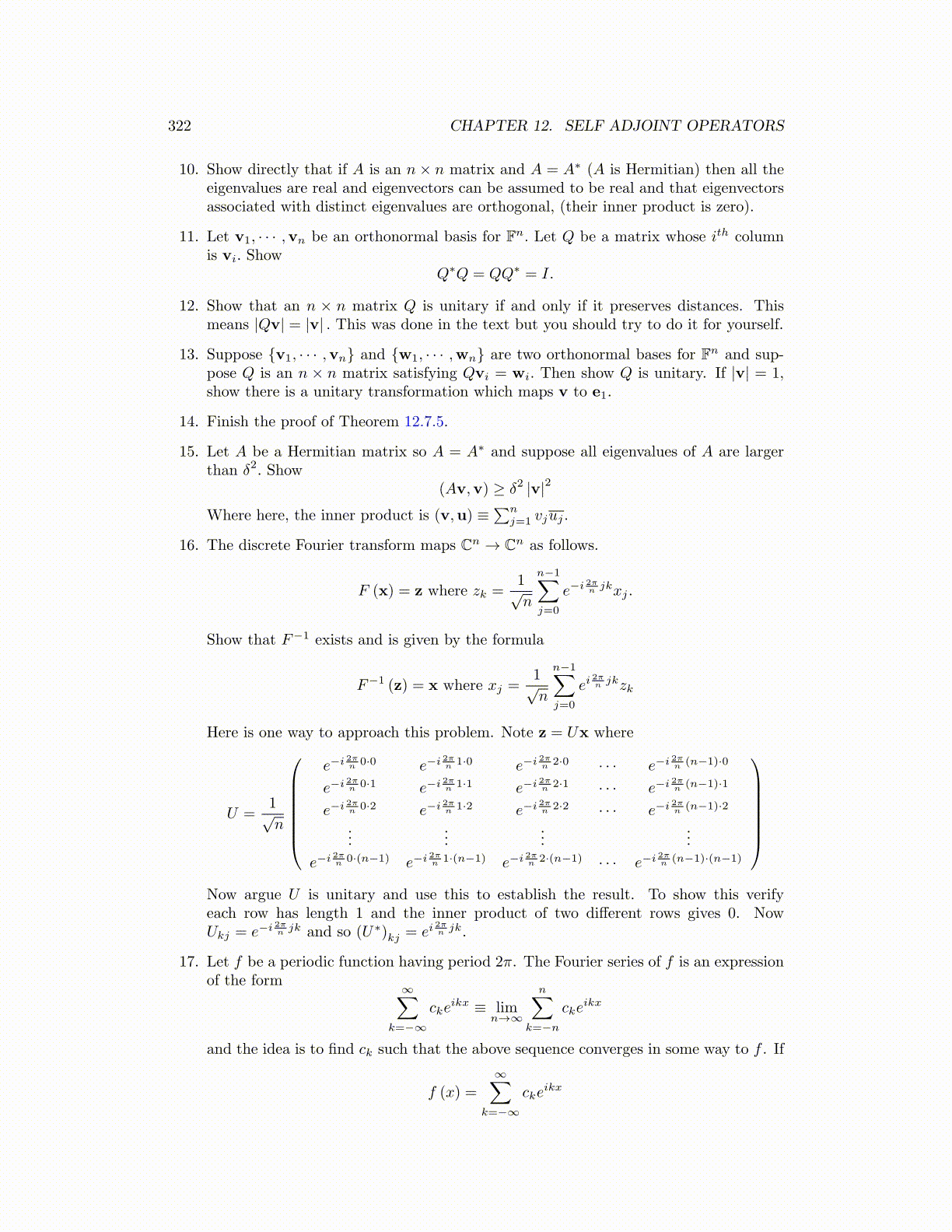
322 CHAPTER 12. SELF ADJOINT OPERATORS
10. Show directly that if A is an n× n matrix and A = A∗ (A is Hermitian) then all theeigenvalues are real and eigenvectors can be assumed to be real and that eigenvectorsassociated with distinct eigenvalues are orthogonal, (their inner product is zero).
11. Let v1, · · · ,vn be an orthonormal basis for Fn. Let Q be a matrix whose ith columnis vi. Show
Q∗Q = QQ∗ = I.
12. Show that an n × n matrix Q is unitary if and only if it preserves distances. Thismeans |Qv| = |v| . This was done in the text but you should try to do it for yourself.
13. Suppose {v1, · · · ,vn} and {w1, · · · ,wn} are two orthonormal bases for Fn and sup-pose Q is an n × n matrix satisfying Qvi = wi. Then show Q is unitary. If |v| = 1,show there is a unitary transformation which maps v to e1.
14. Finish the proof of Theorem 12.7.5.
15. Let A be a Hermitian matrix so A = A∗ and suppose all eigenvalues of A are largerthan δ2. Show
(Av,v) ≥ δ2 |v|2
Where here, the inner product is (v,u) ≡∑n
j=1 vjuj .
16. The discrete Fourier transform maps Cn → Cn as follows.
F (x) = z where zk =1√n
n−1∑j=0
e−i 2πn jkxj .
Show that F−1 exists and is given by the formula
F−1 (z) = x where xj =1√n
n−1∑j=0
ei2πn jkzk
Here is one way to approach this problem. Note z = Ux where
U =1√n
e−i 2πn 0·0 e−i 2π
n 1·0 e−i 2πn 2·0 · · · e−i 2π
n (n−1)·0
e−i 2πn 0·1 e−i 2π
n 1·1 e−i 2πn 2·1 · · · e−i 2π
n (n−1)·1
e−i 2πn 0·2 e−i 2π
n 1·2 e−i 2πn 2·2 · · · e−i 2π
n (n−1)·2
......
......
e−i 2πn 0·(n−1) e−i 2π
n 1·(n−1) e−i 2πn 2·(n−1) · · · e−i 2π
n (n−1)·(n−1)
Now argue U is unitary and use this to establish the result. To show this verifyeach row has length 1 and the inner product of two different rows gives 0. NowUkj = e−i 2π
n jk and so (U∗)kj = ei2πn jk.
17. Let f be a periodic function having period 2π. The Fourier series of f is an expressionof the form
∞∑k=−∞
ckeikx ≡ lim
n→∞
n∑k=−n
ckeikx
and the idea is to find ck such that the above sequence converges in some way to f . If
f (x) =
∞∑k=−∞
ckeikx